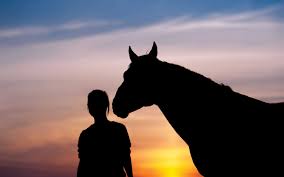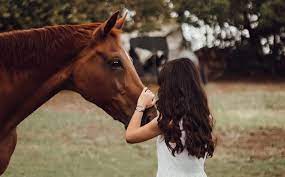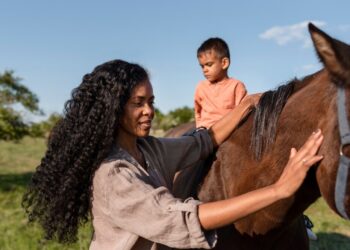Building a strong bond with your horse is an essential part of being an equestrian. A strong bond can help improve communication, trust, and respect between you and your horse, and can make riding and training more enjoyable for both of you. In this article, we will explore some tips for building a strong bond with your horse.
Spend Time with Your Horse
One of the most important ways to build a strong bond with your horse is to spend time with them outside of riding and training sessions. This can include grooming, hand-walking, or simply spending time in their presence.
Spending time with your horse can help you get to know them on a deeper level and learn their personality and preferences. It can also help your horse become more comfortable and relaxed around you, which can improve their trust and respect for you.
Communicate Clearly and Consistently
Clear and consistent communication is key to building a strong bond with your horse. This means using clear and concise cues and commands and being consistent in your expectations and responses.
Horses are highly attuned to body language and nonverbal cues, so it’s important to be aware of your own body language and to use it effectively during training and riding. Consistency in your training and expectations can help your horse understand what is expected of them and can reinforce their training.
Use Positive Reinforcement
Positive reinforcement can be a powerful tool for building a strong bond with your horse. This means rewarding your horse for good behavior with treats, praise, or a break from work.
Positive reinforcement can help motivate your horse to learn and can create a positive association with training and riding. However, it’s important to use positive reinforcement in conjunction with clear and consistent communication to ensure that your horse understands what is expected of them.

Respect Your Horse’s Boundaries
Respecting your horse’s boundaries is an important part of building a strong bond with them. This means being aware of their body language and responses and avoiding actions or situations that may cause them discomfort or stress.
For example, if your horse is showing signs of discomfort or anxiety during a particular exercise or activity, it’s important to slow down or take a break. Pushing your horse beyond their comfort level can lead to distrust and anxiety, which can damage your bond with them.
Be Patient and Understanding
Building a strong bond with your horse takes time and patience. Horses are individuals with their own personalities and preferences, and learning can take time. It’s important to be patient and understanding during training and riding, and to avoid rushing or pushing your horse beyond their current skill level.
Additionally, it’s important to be understanding of your horse’s physical and emotional needs. Horses can experience stress, anxiety, and physical discomfort, and it’s important to be aware of these factors and to take steps to address them.
Incorporate Variety into Your Training
Incorporating variety into your training can help improve your bond with your horse. This means incorporating different types of exercises and activities into your training routine to keep your horse engaged and motivated.
For example, you may incorporate flatwork, jumping, trail riding, or ground work into your training routine. Additionally, you may incorporate different types of equipment such as poles, cones, and obstacles.
Build Trust Through Consistency
Consistency is key when it comes to building trust with your horse. This means being consistent in your training and expectations, as well as in your handling and care of your horse.
Consistent handling and care can help your horse feel safe and secure around you, which can improve their trust and respect for you. Consistent training and expectations can help your horse understand what is expected of them and can reinforce their training.
Listen to Your Horse
Finally, it’s important to listen to your horse when building a strong bond with them. Horses can communicate their needs and preferences through body language and behavior, and it’s important to be aware of these cues and to respond appropriately.
For example, if your horse is showing signs of discomfort or anxiety during a particular exercise or activity, it’s important to slow down or take a break. Similarly, if your horse is responding well to a particular exercise
Be Present in the Moment
Being present in the moment is an important part of building a strong bond with your horse. This means being fully engaged and focused during training and riding sessions, and avoiding distractions that can take away from your connection with your horse.
For example, if you are distracted by your phone or other external factors during a training session, you may miss important cues or signals from your horse. By being present and focused, you can improve your communication and deepen your bond with your horse.
Have Fun Together
Finally, it’s important to have fun with your horse when building a strong bond. Horses are social animals and enjoy spending time with their human companions. By incorporating fun and enjoyable activities into your training and riding, you can strengthen your bond with your horse and make riding and training more enjoyable for both of you.
This can include activities such as trail riding, playing games, or simply spending time in the pasture with your horse. By having fun together, you can reinforce your bond and deepen your connection with your horse.

In conclusion
Building a strong bond with your horse is an essential part of being an equestrian. By spending time with your horse, communicating clearly and consistently, using positive reinforcement, respecting your horse’s boundaries, being patient and understanding, incorporating variety into your training, building trust through consistency, and listening to your horse, you can improve your bond with your horse and make riding and training more enjoyable for both of you. Remember that building a strong bond takes time and patience, and that each horse is unique in their personality and preferences. With dedication, patience, and a willingness to learn, you can build a strong and lasting bond with your horse.














